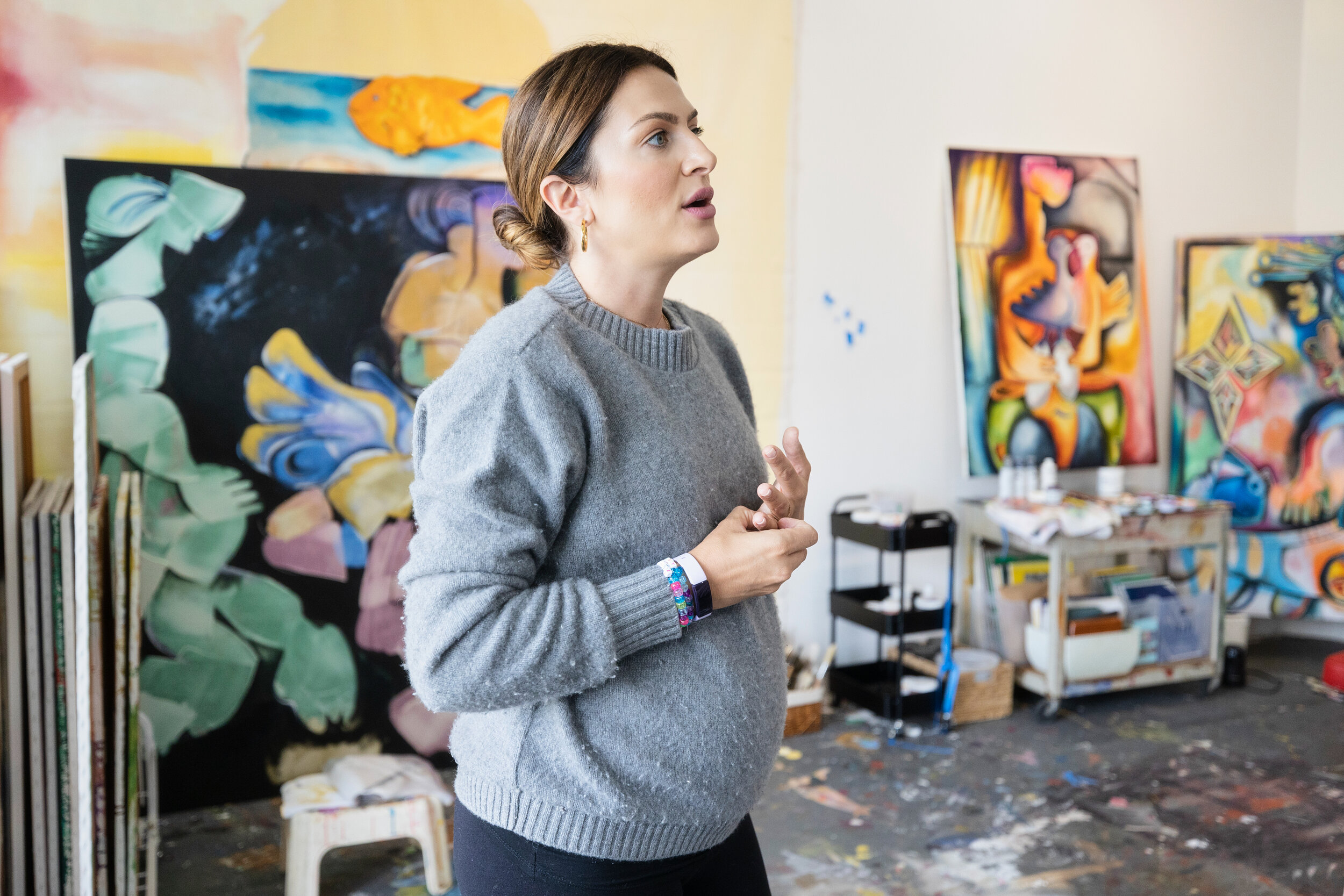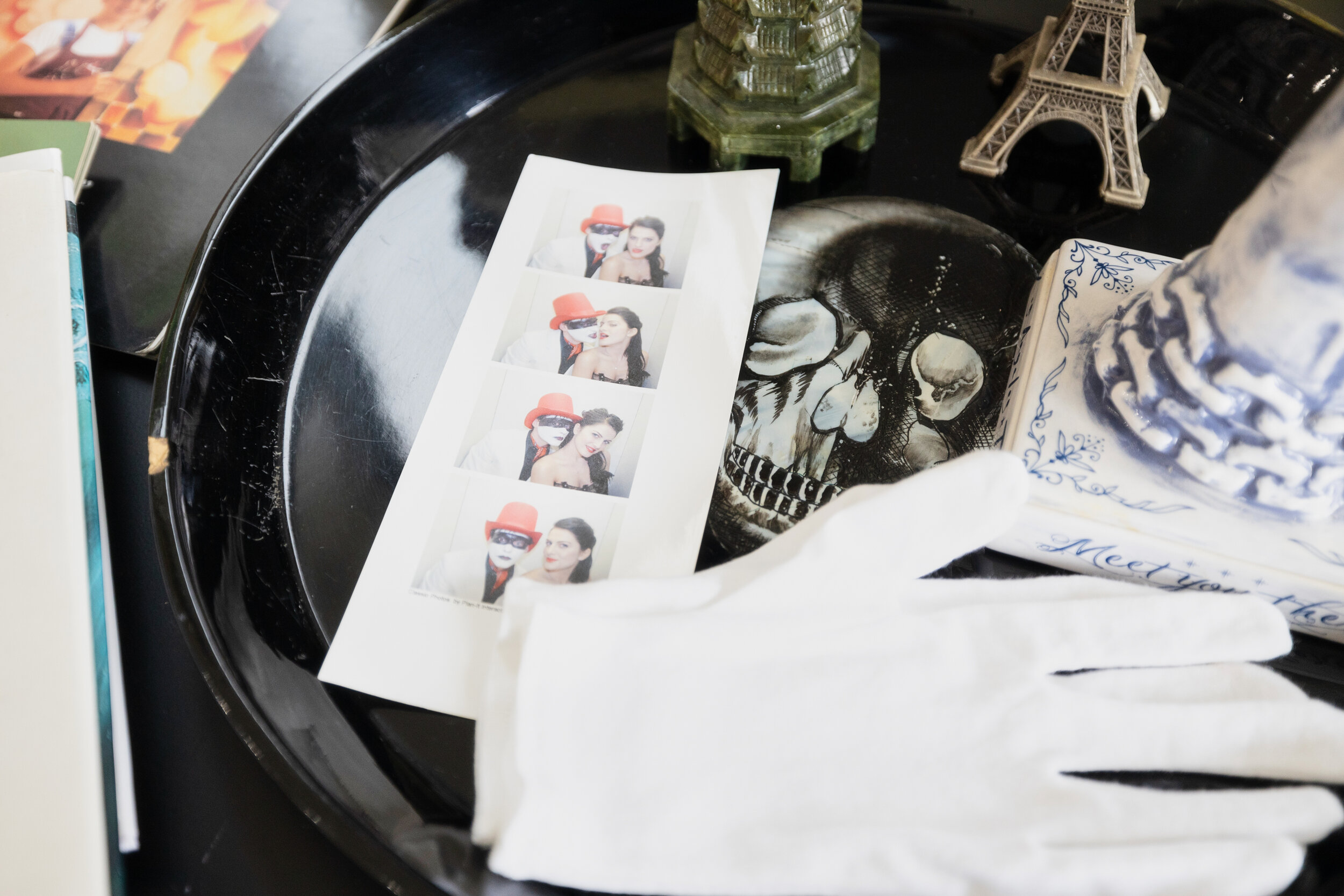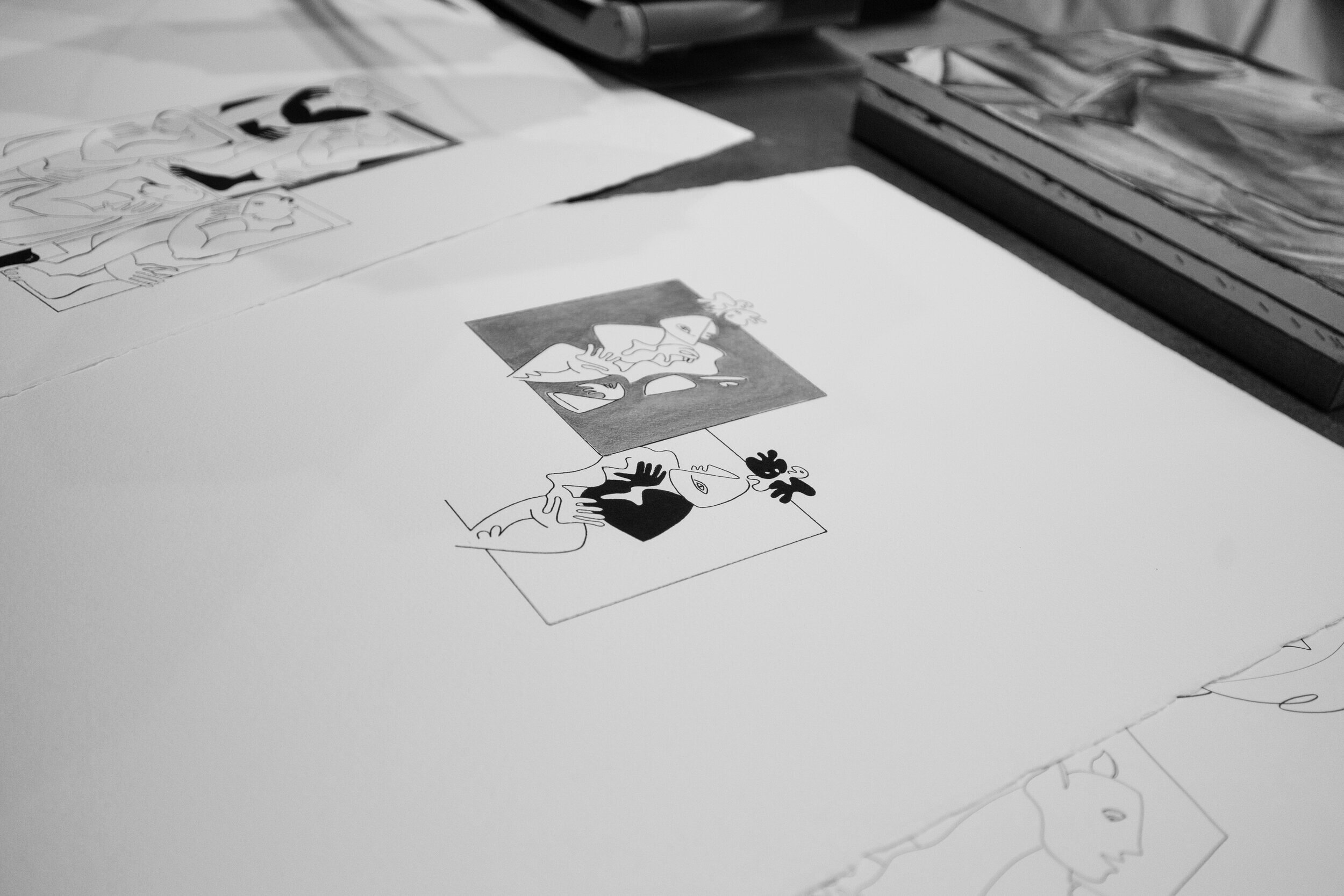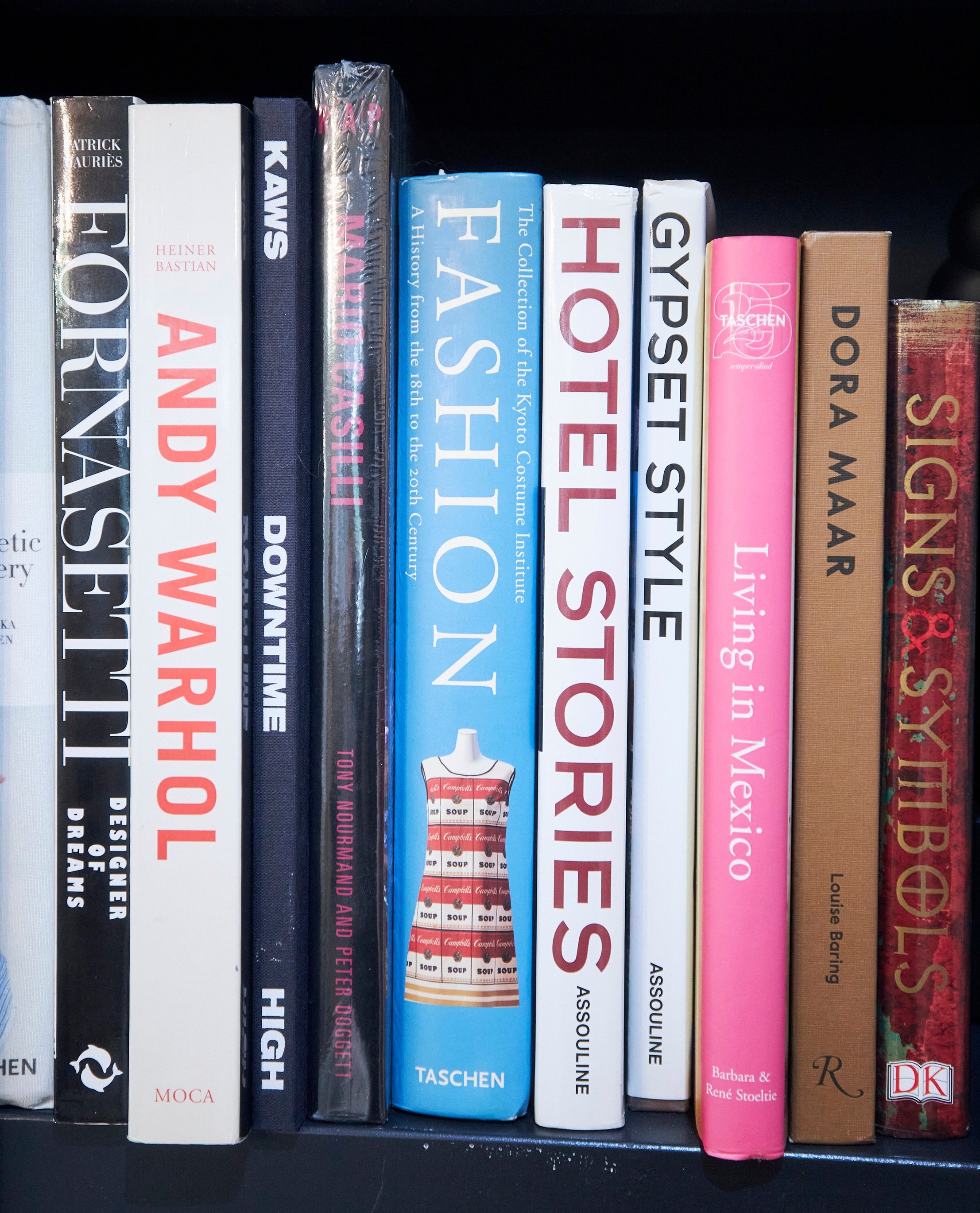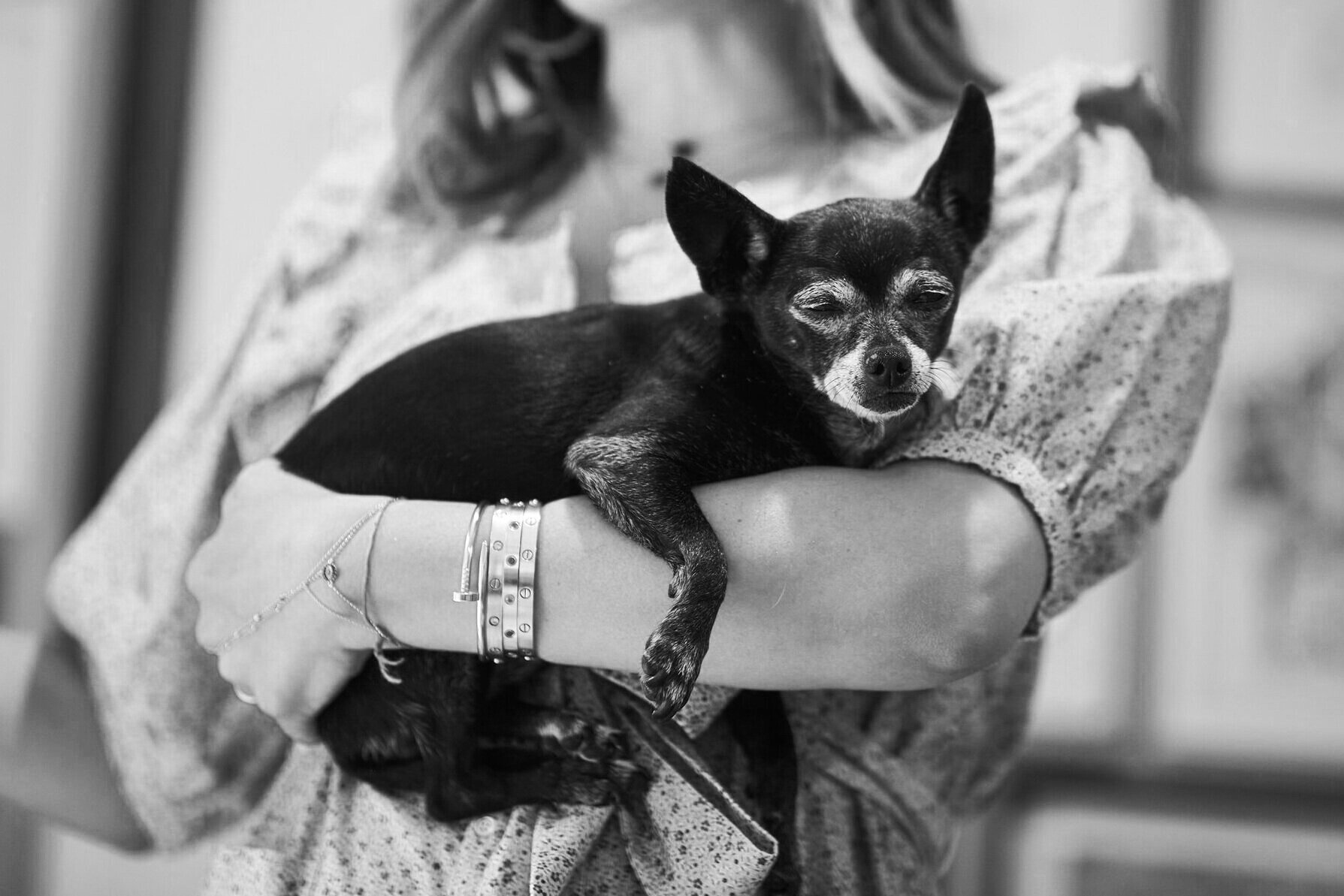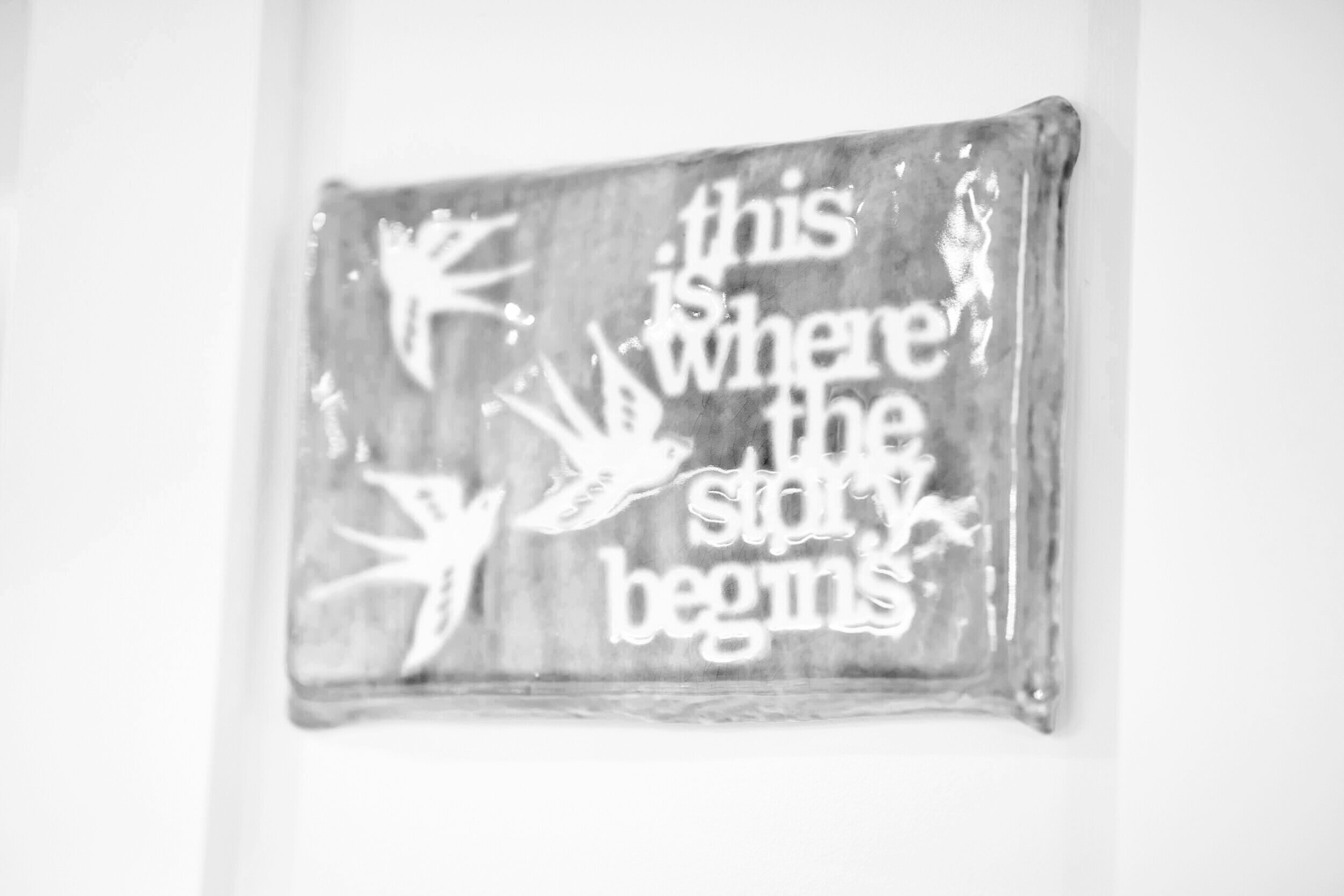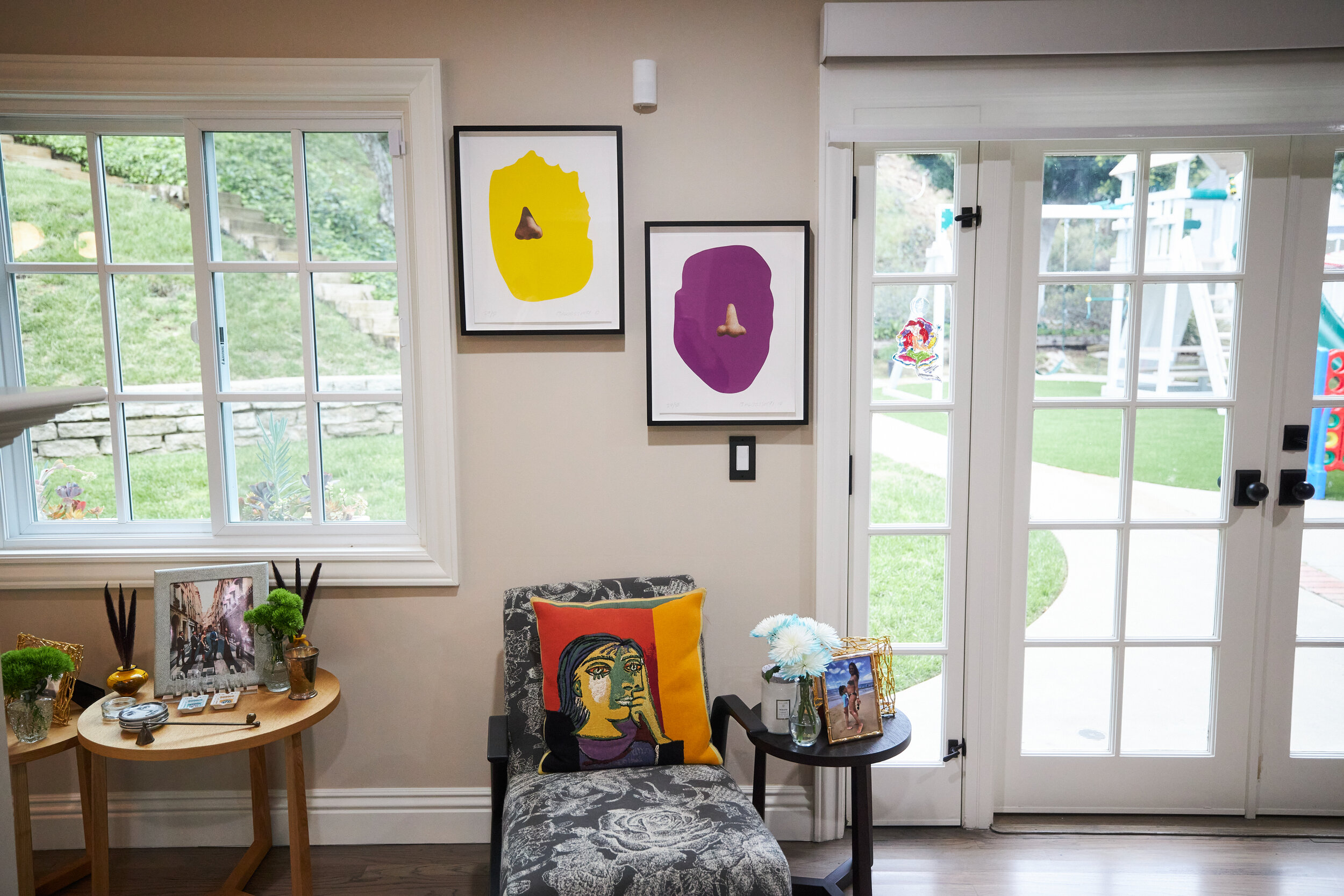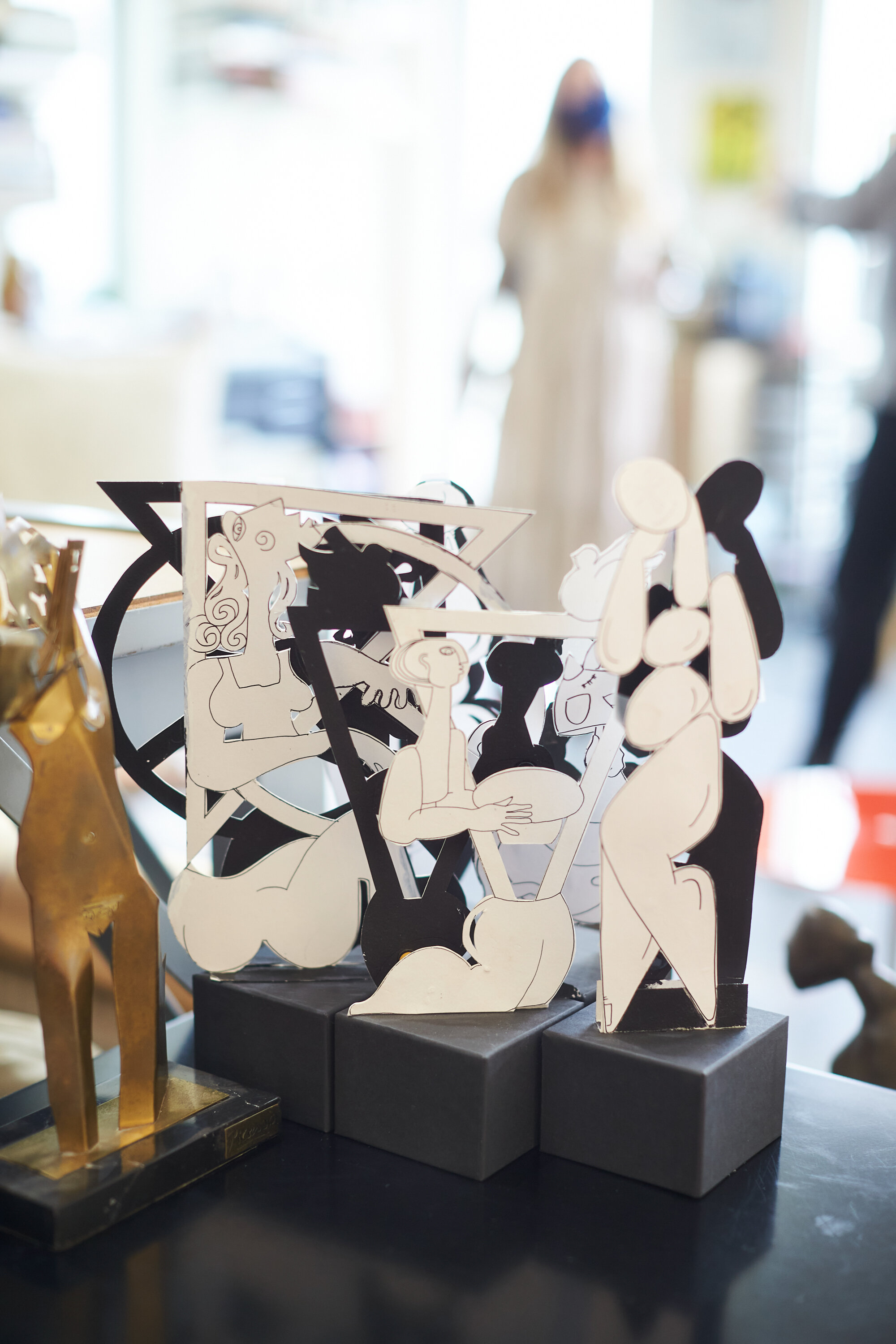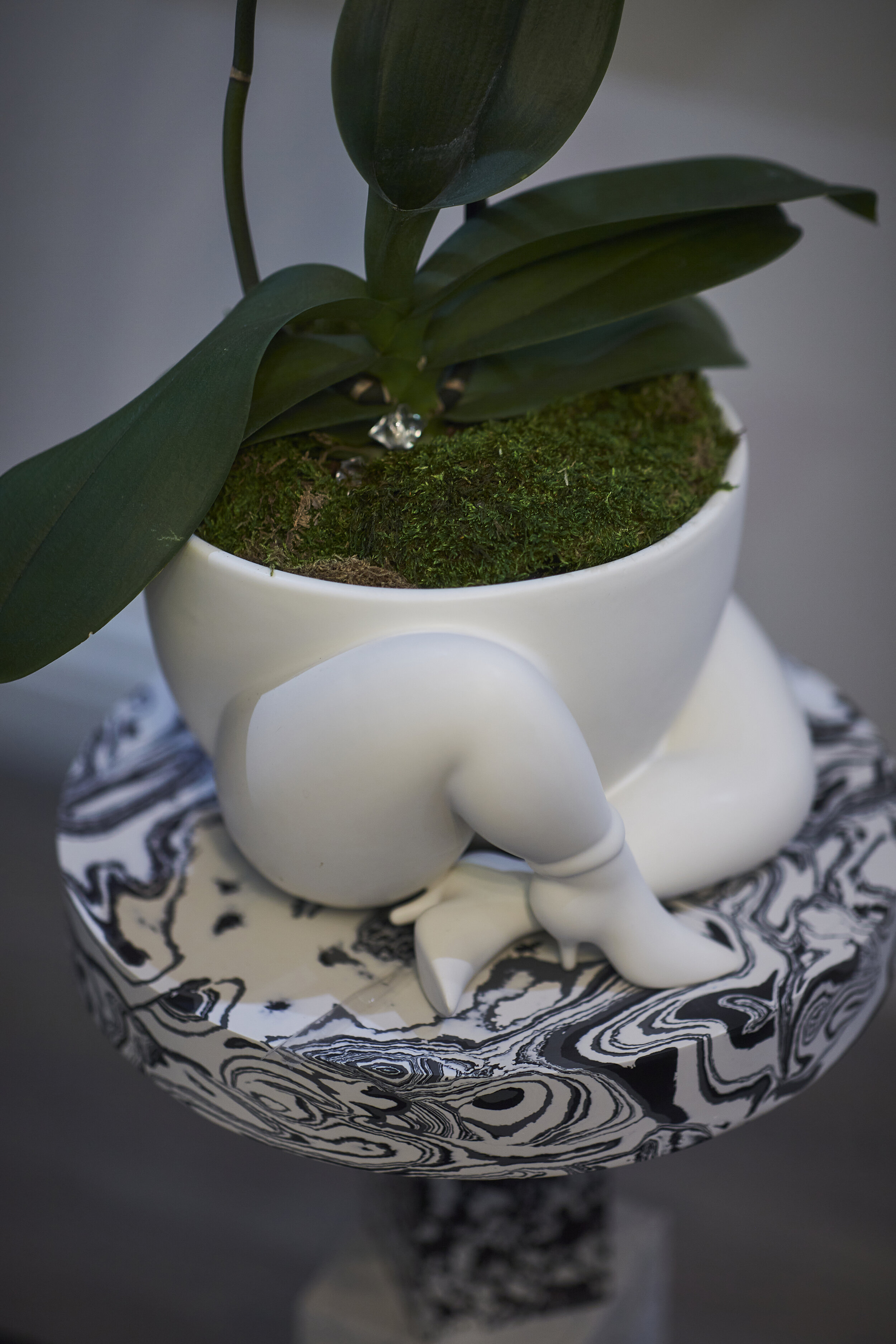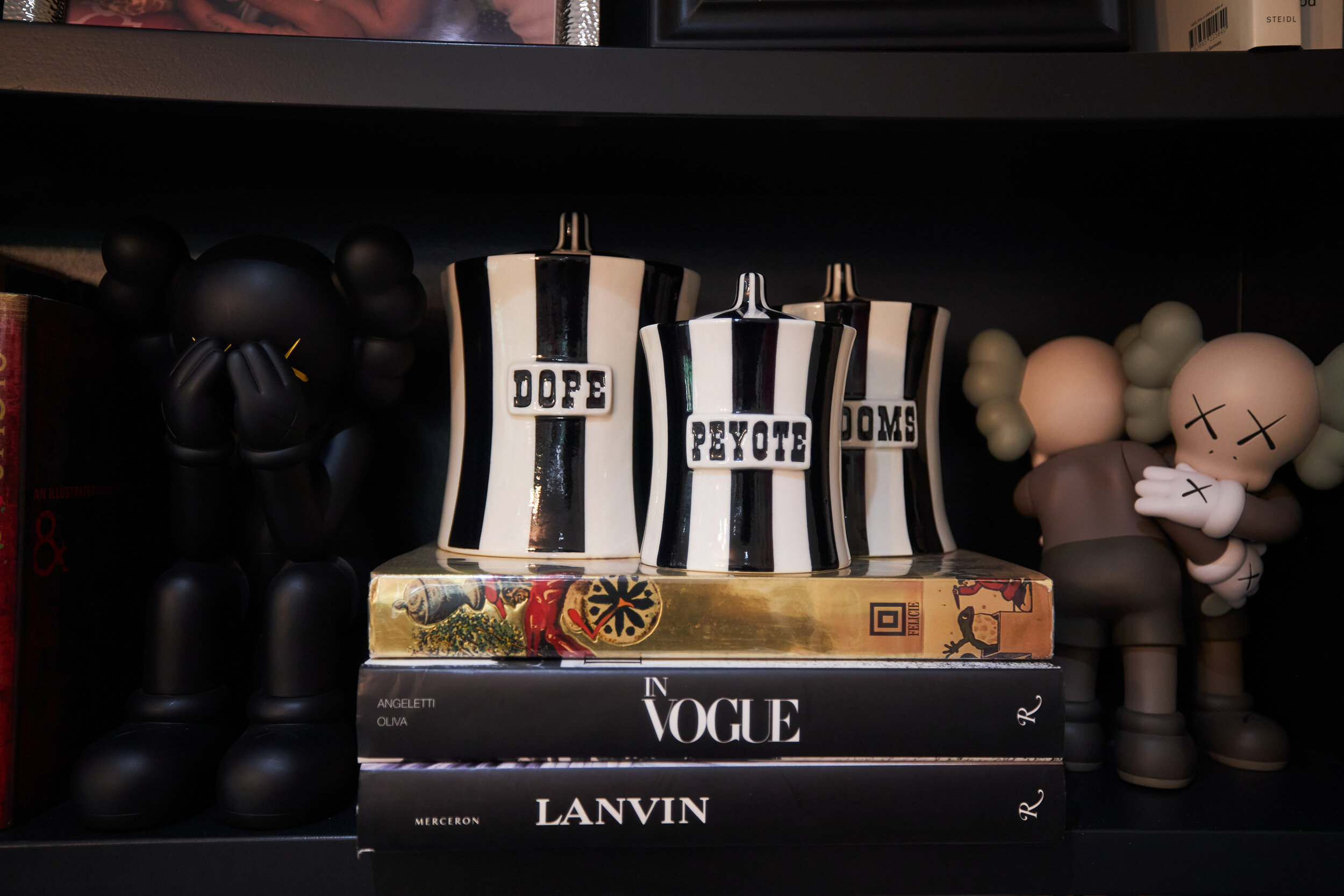Alexandra Nechita
The Romanian-American cubist artist takes us inside her art studio and personal art collection.
By Lindzi Scharf
Photography by Kate Jones
The Petite Picasso is all grown up.
When Alexandra Nechita was just nine years old, she became an internationally renowned artist that many, including Oprah Winfrey, referred to by the aforementioned catchy moniker, a nod to Nechita’s cubist painting style which resembled the iconic Spanish artist’s work. Over twenty-five years later, the child prodigy is now married with a six-year-old daughter of her own and a second child on the way.
Nechita has mostly remained out of the public eye while navigating adulthood and the art world. But 2021 is a turning point for the Beverly Hills–based Romanian-American artist, whose pieces command top dollar and remain in the private collections of Winfrey, Debra Messing, Calvin Klein, Whoopi Goldberg, and David Letterman, in addition to the Vatican Collection in Rome and the Rock & Roll Hall of Fame in Cleveland.
Nechita most recently unveiled a nine-foot bronze neomodernist sculpture of a female figure called “Love Anatomy” in Beverly Hills on the corner of Rexford and Burton Way. To celebrate, she collaborated with coffee chain Alfred on a special-edition mug; with Little House Confections on a uniquely Nechita-inspired cake; and with Beverly Hills chocolatier andSons on a sweet capsule collection.
Nechita is used to having a lot on her plate. Over the years, she’s held exhibitions and had pieces featured at the Heal the World Institute in Tokyo, the Winter Olympics in Salt Lake City, the Ville de Meudon-Musée d’Art et d’Histoire in France, and the National Museum of Art in Romania. She’s also been the subject of eight books including “Alexandra Nechita: Child Prodigy, Painter with Heart and Soul.”
“I was a strange child,” Nechita says, seated on a red chair in her Beverly Hills art studio, which is around the corner from the home she shares with her husband Dimitry Tcharfas, daughter Tevva, and three dogs. “I must have been very weird.”
HER HOME AWAY FROM HOME
A stroll through Nechita’s packed art studio provides insight into her mind.
“It’s madness in here,” she says, surrounded by sculptures, metal wire, brushes, paint, books, and colorful canvases — some complete, some incomplete — within a converted area once occupied by a tennis court behind the childhood home she bought for her family in 2003. Nechita and her husband, Dima, lived on the property for a handful of years before they purchased their first home together in 2010. “I always came here for work and I still do,” she says. “I work at this unconventional pace in that I start something. I put it aside. I go back to it. I forget about it for five years or forever.”
Nechita rummages through a cabinet of loose sketches. “This is obviously a collection of years and years of labor and ideas,” she says. “There’s thousands of sketches.”
Dima looks on. “We’re constantly going through the work,” he says.
“He’s been trying to catalog it for years,” she adds.
Nechita says she’s constantly moving pieces in and out of the space to make room for new projects. As a result, she has another storage facility on site and two huge warehouses where much of her work is kept.
“It’s dangerous,” she says, “because I just keep starting shit and I often don’t finish it — or I do finish it, but there’s not trajectory for the work yet. It’s always been my parents’ biggest dilemma. Obviously, now they can’t say much because it’s my livelihood, but before when they weren’t sure where this was going, they were like, ‘You make too many things. What are you going to do with it?’ I’m like, ‘I don’t know. Who cares? I have so many ideas. What am I supposed to do? I made it. I needed to get [it out of my head].’ It’s a cathartic experience for me. It’s suffocating to not say and do it. It squanders me completely to try to control those ideas.”
Nechita insists they’re not always good ideas. “Half the time, in fact, they’re terrible,” she says, “but it’s this impulse to release them that is important.”
She holds up a sketch she created when she was eight. “It’s such an emotional expression for me,” she continues. “I don’t often have memory of actually making them because it was just that moment that was captured and released.”
She calls the experience “visceral” and says the work might “mean nothing,” but that it’s a “physical, raging impulse” she feels the need to put on a blank canvas. “Then three days later, I’m [painting] that canvas white again because it’s like, ‘Okay, got it out.’ It’s as simple as that.”
THE PETITE PICASSO
Nechita says she can hardly wrap her head around who she was as a kid, but she feels grateful that she found her passion at such a young age. She often wonders what she would have done if she hadn’t discovered art as a means of expressing the emotions she felt as a child whose family fled communist Romania when she was one and a half years old.
“What would I have done if I didn’t have a way to release [what I was experiencing]?” she asks aloud. “What would have happened? I think I would have become paralyzed with all of these things in my head and all of these feelings. More importantly than that, what if I didn’t have parents who thought that it was an important thing to do?”
Nechita says, “My parents weren’t shaping me to be an artist or make a career out of this. It was a laughable thought in fact. For most people, especially parents, it’s a laughable thought because you think law school and medicine and practical jobs that offer security. They came from a communist mentality. They came from a place that constantly told them what not to do and how do it if they were doing it and what time to start and what time to end it. A big part of them supporting me doing this was also [embracing] this freedom: ‘She wants to paint. Cool.’ For so long, they suffered. We all need to survive. We all need to pay bills. We all need to provide for our families, but how long do you endure that until you completely lose yourself, you know? The possibility of doing something that I was stoked to do on a daily basis was more exciting to them than the promise of a [more typical] job.”
That’s not to say Nechita didn’t feel a sense of responsibility at a distinctively young age. Since she was a child, she says, she’s been “accustomed to” a sense of “duty and responsibility and financial burden and a lot things that most people don’t experience until they’re adults.” However, she insists, “I chose to do these things. I had a family who supported everything I was doing, but they always checked in and said, ‘Are you sure? Are you okay? Do you want to cancel this?’ It wasn’t like, ‘I didn’t have a choice and poor me and oh my god, I had to support my mom and my dad.’ By no means. But it’s who I am. It’s something I’ve learned to shake a little bit because I realize how incredibly damaging it could be in the long run, but it is who I am.”
GROWING UP
Nechita’s childhood differed greatly from the life she’s built for herself. “I didn’t grow up with means,” she says. “I understood what sacrifice my parents were making all the time. My mom and dad couldn’t afford sliced bread. My grandma would bake bread for my school sandwiches. My sensibility was framed differently than even that of my brother’s who was already born into a very comfortable life compared to me, financially. Those things all impacted the way I processed information and the way I lived through certain things inadvertently.”
“It’s not like I was sitting there trying to siphon through philosophical existential issues as a child,” she continues, “but those things were obviously affecting me. My dad wasn’t concerned because he was like, ‘She’s staying out of trouble and there aren’t a hundred kids in our apartment, it’s perfect.’ But my mom was concerned. She was like, ‘She is antisocial and weird and she doesn’t have enough friends and she doesn’t speak English, so let’s fix this.’”
Her parents saved up enough money to take her to tap dancing class. “I had no desire,” she remembers. “I was super content with coming home from school and drawing. It’s an isolating practice to have, as a child especially, but it was the only thing that resonated with me. I was lucky that I found that at a young age.”
Her parents embraced her one-track mind and instead directed their attention elsewhere. “They focused on exposing me to the world and being honest with me, including me in settings that were otherwise not appropriate for kids; allowing me to participate in conversations and dialogue,” she recalls. “They were shaping me to be prepared for whatever was thrown my way. I think that it’s not so much about making a kid who likes violin practice for seven hours a day. It’s like, ‘No. How about we make good people out of these children and if they are inclined to do something or inclined to be better than the average child at something … let’s encourage it with classes, with tutors, with this, with that.’ They inadvertently shaped me. They prioritized raising a human being over making an artist out of me.”
THE COLLEGE YEARS
Despite her thriving career — which included commissions from the Billie Jean King Foundation, Andre Agassi Foundation, Frank Sinatra Foundation, and Grammy Awards, in addition to a commemorative coin set approved by Queen Elizabeth II — Nechita attended art school at UCLA when she was 18.
“I was always a nerd,” she says. “I love school. Once my kids are grown, I’ll probably go back and get a PhD; I’ll probably end up teaching when I’m an old lady.”
Nechita says she enjoyed being around like-minded individuals who were equally passionate about art — as opposed to the business of art. “I was always surrounded by people who liked making money, and that was great, but that didn’t incentivize my process at all,” she says. “Going to art school was the first time that I felt like I was surrounded by people who liked being creative. For the first time, I was around artists and some better than me actually, so that was an exciting experience.”
While at UCLA, she met her husband, Dimitry.
THE MEET-CUTE
“One of my friends from art school was dating his best friend,” she explains. “They set us up on a blind date that I was 2 hours late to. I’d had this meeting at the Four Seasons and I couldn’t get out of it. I was very formally dressed, so I changed in my car on the way to meet him. They were literally eating their dessert. I was like, ‘I am so sorry. This is a terrible first impression.’”
Even so, they bonded over a shared love of the arts. He grew up attending operas and going to museums. He’s personally passionate about fashion design.
They’ve been married since 2014.
“Dima and I have been together for 17 years,” she says. “Listen, we were kids. We essentially raised each other and formed each other in ways that suited us personally. He was accepting of this reality and who I am and understood that I had these whims where I’d go and I’d paint and I’d disappear.”
“I don’t think, if I were to date a 45 year old man now, he’d know what the fuck to do with that,” Nechita jokes.
TRY A LITTLE TENDERNESS
Nechita’s work has evolved with her.
“This is an egotistical practice,” she admits. “It’s very much an extension of me and whatever I’m doing and whatever I’m going through and the experiences that I’m having personally. With that being said though, I do know that I have this duty as an artist to say things and be a voice for someone or something; I do promote dialogue about other bigger things, but for the most part, these are just really intimate experiences.”
After giving birth to her daughter Tevva in 2015, Nechita noticed a change in her approach. “I opened myself up to a tenderness that I wasn’t [previously] that keen on,” she says. "I didn’t feel like it was a weakness, but I protected myself in that way. I lacked a femininity in my work because I always felt like I had to prove how good I was because I needed to justify why I was a child or a woman and doing well. I didn’t understand that I was a minority in being a girl when I was young, but once I got into an adolescent phase and certainly in college I felt it.”
As a result, she says she was guarded and felt the need to protect herself in a variety of ways — both personally and professionally. “I always carried myself with poise — that was a way of protecting myself,” she says. “I always educated myself — that was a way or protecting myself. I always spoke thoughtfully — that was a way that I protected myself when I was younger — and even now. But I certainly used all of those things as strategies to create a bubble. In doing all those things right, I think you can lose some special things and ideas and feelings and sentiments.”
Motherhood changed that. “The work took a turn and became softer,” she says. “I’m not referring to the aesthetic of the work necessarily. I think the way that I interacted with the process of making it became softer and more tender and less defensive. I don’t know if that’s because I had a girl. I’ve always been emotionally in tune and sensitive, but I’m also the first to admit that I wasn’t the mom who was like, ‘I love when they’re a newborn and they’re little.’ That wasn’t the connection I had with being a new mom. It was just suddenly this realization that this is a member of the world now that will be who she is because of what I do or don’t do. That realization was so overwhelming and that suddenly became the biggest responsibility of my life. I think that I became much more aware that this was no longer just my own journey.”
That’s not to say that art comes second. “Before I was a mom, I was an artist, so that very much takes first place to parenting her,” she says. “I don’t separate the two in a way where this gets shafted. It got shafted this year because of [COVID-19], and everyone didn’t know what the hell was going on. I’d gone through a lot of this stuff in the beginning [of Tevva’s life, when I navigated balancing parenthood and art], so I already knew I wasn’t going to be that person that was going to forget who I was before I made this decision to very wildly bring life into the world.”
She laughs. “And now I’m doing it again.”
MOTHERHOOD-ING
“Children give you a different purpose that you couldn’t have had before,” Nechita says. “It doesn’t mean that you’re a better artist. There are plenty of people in this world who are incredibly impactful citizens of the world that don’t have children.”
However, for Nechita, it was never a question. “Culturally, I felt like it was every woman’s obligation to create offspring and have legacy through their children,” she says. “That’s the mentality that I had. It’s not so much that I believed in it, but I kept hearing it and that’s what I knew.”
Nechita leans heavily on her husband for support. “We have an incredibly connected relationship in raising her and he’s incredibly involved,” she says. “He’s not involved because I make more money. He’s involved because he wants to be involved and he likes it and he’s happy to give me the space.”
All the same, Nechita chooses to be involved in the day-to-day. “There’s a sacrifice you make as an artist,” she says. “But in passing through these last six years, I realized that it’s fleeting and it goes so quickly. It really does. While yes, I could possibly be making extraordinary work in this time rather than making an extraordinary human being, I’ve now chosen to do this and so I will hit the pause in some capacity, but not fully.”
She says the only real change since becoming a mother is that she’s not always doing things based on her own timeline. “Some nights, I sleep less because I end up wanting to be here,” she says, looking around her art studio. “In the beginning, I was like, ‘I can’t wait until 6 pm. She’s in bed. My day starts now.’ I caught myself saying these stupid fucking meme one-liners, like, ‘Is it five o’clock? I need a drink.’ But I realize now, this moment is a vignette of my life. It’s literally a vignette. But it’s such a formative one in hers and it’s equally formative for me, but this is really make or break for her—what she’s getting out of us and these experiences, so I’ll take a little bit away from here, or I’ll take a little bit away from my sleep, or I will go do a project in Romania, like I did for two months where I didn’t see her, but I understand that when I am doing what I am doing with her, I am doing it with her and I’m all hers. And when I’m doing what I’m doing in here, I’m here.”
Nechita says compartmentalization is key. “I had this fantasy that I was going to have this perfect balance and do everything at the same time,” she says with a laugh. “I was searching for ‘The Balance,’ like I was searching for some fucking fountain of youth and I realized, for someone as smart as I am, I found myself feeling so stupid for searching for something so impossible. It doesn’t exist.”
A PATH ALL HER OWN
Nechita has never considered any other career, although she has other interests. “I don’t think that this is where I stop,” she says, explaining she’s always been interested in writing and public speaking. “Art is my constant. This is my refuge and no matter what I’ll do it, but I’d like to get to a place in my life where my livelihood is not contingent on it and I can create for the sake of creating.”
She credits her parents’ business savvy with providing some freedom over the years. “My parents were smart,” she says. “They invested most of my money in real estate when I was young and so it’s offered me a lot of that flexibility, but life is more expensive with children. I’m still content to see the sales of my work sustainable, but I’d like to get to a place in my life where — I mean, doesn’t everyone? — you want to be able to do what you love doing without worrying if it’s going to put dinner on the table.”
Even so, Nechita recognizes that she’s lucky to call herself a working artist. “I’m such an isolated and specific example,” she says. “First of all, most artists don’t live off their work. Second of all, most artists don’t get to sell something until they’re ancient or they’re dead.”
HER ADVICE
She often struggles to advise aspiring artists. “I find myself cornered when I get asked, ‘What’s your advice?’” she admits. “It’s hard because there is nothing normal about my story. It is unique in absolutely every possible sense. It is unique in that I’m an immigrant. It’s unique in that I’m a girl. It’s unique in that I was a child success story that didn’t turn into a complete shit show. It’s unique in that I’ve actually continued doing this, and I will continue doing it regardless of what it does or doesn’t do for me in my career.”
She points out that everyone’s circumstances differ greatly. “You must tread lightly when you solicit advice from people,” she says, “because we all like to be like, ‘They’re a success story. They look good. They make money. They have a good marriage. Tell me what to do.’ We can give these good tagline pieces of advice and I have plenty of those up my sleeve, most of which have been offered to me through the years that I keep recycling, but I think you need to be honest with who you are and what your story is and what choices you have made before you try to implement these general things because otherwise, they don’t work.”
As for those “taglines,” she offers, “I think you should be hard working. I think you should be willing to sacrifice. I think you need to make choices on what you prioritize. I think you need to have a work ethic that can eat up the whole world.” But, she says, luck and circumstance will always play a part.
Nechita feels similarly about relationship advice. “I get frustrated when people are like, ‘How did you guys do it?’” she says. “First of all, we did it before social media was a thing. We didn’t have the swipe right, ‘I can have a new person because I’m bored of this flavor of the week.’ And we also come from a different mentality culturally. We’ve witnessed both our parents go through incredible turmoil within their relationship and work to make it better and truly move forward. You try and you keep trying. You don’t just throw in the towel after one, two, three times. I’m not saying exhaust a decade of your life, but I think it’s important to [make an effort].”
Nechita puts the same effort into Tevva’s self-discovery. “I find myself, as a parent, trying to offer all these different outlets for my daughter,” she says. “I would like to offer her the opportunity because I can only imagine if I had so many internalized feelings [and no outlet what would have happened]? … If children don’t have an opportunity to remove those stresses from themselves, you’re cognizant as an adult, you see what happens when you just pile and pile and pile. We need to let them go. So I think that it’s so important to offer.”
For Tevva, that desire translates to theatre, dance, and music. “When she physically shakes it out, she feels better,” she says. “As a parent, your duty is to try to provide as many routes to discovery within whatever you’re able to. Sometimes it’s a sheet of paper, sometimes it’s putting the radio on, sometimes it’s a fancy class.”
LOCKDOWN LIFE
Like most parents, it took Nechita time to find her footing during the pandemic. “If I didn’t have a child, I would have certainly been painting all day long. It would have been perfect. I wanted to be like, ‘I’m going to make stuff. I’m so inspired,’” she says. “But instead I was trying to figure out, ‘How am I going to be a teacher and how am I going to make it fun for her?’ Finding any space within that chaos to stop and pause and try to be creative felt way too selfish in the very beginning. I was like, ‘That’s not a priority right now. I need to make everything else work.’”
Nechita says she started to get the hang of things — and then “I threw another wrench into everything because of my pregnancy.”
But she’s ready, once again, to balance work and having a newborn, even if last time she remembers thinking, “I don’t sleep and I can’t go paint until four in the morning and oh my God, my boobs are hurting. I’m so sad and I don’t know why.’” While the brief, but sudden, loss of identity came as a surprise to the then-new mom, Nechita is better equipped a second time around because, she says, “Art is who I am.”
Similarly, Nechita looks forward to seeing who her children will become. She says she has no doubt that Tevva will follow a path all her own. “She’s not mine,” she says. “I don’t own her. She is who she is and she belongs to herself only and so whether it’s when she’s 18 or whatever, she’s off on her own and she too will do all the things that she’s going to want to do.” Which is no different from Nechita herself. “I will always have this world to return to,” she says. “Why can’t the narration and the storytelling begin then and become even better?”
HOW SHE LIVES…
“The irony is that I’m an artist, but we collect all this other art from other artists,” Nechita says. “There’s this ethos in the art world that you collect this specific set of artists because they’re the trendy ones and they’re the important ones and they’re the good investments. I suppose that someone who is spending $9 million on a painting can argue more than I can, being the kind of collector that I am, but the reality is you live with these things. If they don’t inspire some kind of joy or if they don’t carry a messaging that I think is meaningful… I mean, I wake up every single day and that’s what I see, so it’s no different than waking up with the husband I chose or the child I didn’t choose, but that I love to death or whatever, you know? I think it’s really important to collect things that represent something you actually really like as opposed to doing them because everyone else is doing them or your art advisor told you to.”
KAWS
“Dima’s particularly obsessed with Kaws,” she says. “When we first moved into our former house, he was bringing in all of these cartoon things. I like them, but they’re not my first go-to that I would have collected.”
TOM DIXON TABLE WITH CB2 CHAIRS
“We love little random things,” she says, “like that is a Tom Dixon table that I’m obsessed with that was insanely priced, but I was like, ‘I need it.’ I literally felt the way I felt when I look at a sculpture or painting. We get random stuff that adds a specific character that we like and then honestly, last comes the furniture. This is a reupholstered couch that I’ve had for 15 years in my old home and it used to be dark grey and we just reupholstered it. These are CB2 [chairs], but it works.”
THE SHELF OF COMPROMISE
“This is the shelf of compromise,” she says with a laugh. “These are a lot of the things that Dima adores and saved up to have, so all of the cartoon creatures are Kaws pieces. My husband and I have been together for 17 years, so there’s a lot of history and pictures. Our favorite thing to do together was Halloween. Ever since the first year we started dating, we went all out on all of our Halloweens with crazy costumes and my husband was such a trooper. I’d, like, drag queen him out to the max. He’s like, ‘If I have a tequila, I can handle anything.’ So that’s when we were both devils. It was such a long time ago.” She points to another set of photos nearby. “That’s my husband and I with my best friend. Then, this is us for our daughter’s first birthday, five years ago. That’s me in the hospital when she was born. Our wedding day. Again, my best friend. He’s everywhere. Then here, same thing… a lot of Kaws.”
DANIEL ARSHAM
“The Boombox is a Daniel Arsham, another artist that my husband is fond of,” she says.
ART ISN’T AN ACCESSORY
“The funny thing is — we had no furniture, but our walls were covered in art,” she says of when they first moved in. “I’ve had so much experience with collectors over the years and they think that just because they’re paying for something, they can dictate a painting in terms of commission work. It’s interesting. They’ll say, ‘This is my budget and I want three figures and I want purple and gold and I want blue polka dots in the left corner because I have a blue polka dot couch that’s going to be the right of the painting.’ I’m like, ‘Cool. So make it yourself because you obviously know what it is you need.’ It’s an interesting philosophy with trying to set up [a home]. Obviously, you want the work to work well with the aesthetic of the home and the furniture. Art isn’t an accessory. I mean, I don’t see it as an accessory.” She explains: “That’s why I’ve never really taken commissions unless I’ve been able to comfortably work with whoever it is and it’s somebody who understands that the beauty in the commission is that you’re able to — yes, you can choose a size orientation, you can kind of say ‘Please stay away from really bold colors.’ You can sort of say ‘I’d like it to represent something relating to my family or whatnot.’ I don’t take offense to it, but I find it interesting that people expect that that’s normal. Those are people who don’t understand the incredible honor that it is to live through a creative process. It’s not a bad thing. It’s just by virtue of circumstance and who they are. But as an artist, I would never dare say that to another artist. Just simply because I understand that when you choose this path you choose it precisely for the freedom that it provides and for the liberty that it provides. It’s always very funny to me, but I get it because look I have a home and I want things to be cohesive and I want it to work, so I understand, but then at that point — shop around.”
SAM DURANT
“This is a Sam Durant that we just bought — the pink neon sign — Do Good Things.” she says. “That’s the driving force in the way that we collect and the way that I also try to make work. It was another one of those impulse [buys], but it felt right and we got it.”
THE SECOND SHELF OF COMPROMISE
“This is a piece, unfortunately, that has gone through a lot,” Nechita says, referencing a sculpture that has a small crack. “It’s a piece of ceramic that I made in Vallauris [France] years ago. I’m not so precious about my work to be honest and that’s why I think I’m always encouraging people to touch it — even if it’s at the expense of the work’s wholesomeness.” She points to framed photos nearby. “That’s our little girl; then my husband and his best friends and one of my best girlfriends,” she says.
FASHION & ART BOOKS
“I’m a big art book collector,” she says. “We literally have boxes and boxes and boxes. Our dream is to eventually have a library room because we’re both avid readers. We’re [constantly] seeking inspiration and looking for ideas — and especially this last year without being able to go to museums and shows all the time like we normally would. It’s nice to have these cool references that you can feather through.”
HER PAINTING
“This is a piece called ‘Ghosts of Doubt’ that I made in the last two years,” she says. “We tend to rotate art because I have so much of it and we keep collecting other artists. We keep bringing in one piece and then we’re like, ‘Okay. We’re over this one. Let’s bring in another.’ Or perhaps one sells. ‘Let’s switch this out. Let’s put something else in here.’ There was another painting here a couple of months ago that ended up having to go to one of my galleries for a client to buy, so we put this one up.”
THE LIGHT FIXTURE
“There has to be a practicality and a choice in what you spend on and what pieces are important,” she says. “For us, it starts off with the art and then it moves into the light fixtures, which probably would be the next thing that we’re really big on.”
HER RUGS
“My rug is disgusting because I have dogs who pee everywhere,” she laughs. “When we first moved in, we had an interior decorator help us. I was like, This is the deal. I’ll invest in pieces of furniture that I know that I can take to another house or can maybe even relocate to another room, but I am not spending money on rugs. My budget for a rug is $150 — for a 8 x 12. This was a $99 rug that we got from Gilt. It has been peed on about 12 times. It’s unfortunate. I know what rugs do for a home. They change everything. It’s like the ribbon on a present. It’s like giving a gift without a ribbon. … Look, everyone is different. There are people I know who have dog nannies, so they don’t care. They can have a $12,000 Persian rug because their dog’s getting taken out every 15 minutes. People have people who take care of their dogs exclusively — the same way you have someone who watches your child. They’re not outside on the floor getting dirty and then jumping on your beautiful Versace couch or whatever. And that’s fine, but for our lifestyle and the way that we live and the practicality of it, [this works for us]. Before COVID, we had kids in and out of here constantly. Even the most well-behaved child is going to run in with muddy feet and plop themselves on the couch thinking it’s okay. We can’t run the risk of having things be so precious in the home where it’s going to cause a heart attack for us every time we have a guest over.”
TOFU
Nechita has three dogs, but Tofu was the first to capture her heart. “She’s 100 percent a human stuck in a dog’s body,” she says. “She’s my favorite. Don’t tell the other two.” Nechita says she always wanted a Weimaraner. “My husband entertained the idea, but subconsciously was like, ‘We’re not getting a horse-sized dog in this 1,500-square-foot house.’ I actually always had a repulsion to small dogs.” She laughs. “The things you run away from are the things that chase you. Always.”
TOFU: PART 2
Nechita’s father found Tofu abandoned at a home he was flipping at the time. “They ambushed me into taking a dog,” she says. “They knew me seeing the dog in person it would be a no-brainer. Even now, there’s this deep-seeded, profound gratitude that she has for us. … She turned into this child that we took everywhere. I’d sneak her into the Arclight. For my husband’s birthday, we always go to Chateau Marmont for lunch. So we took her with us. My dad’s favorite thing is to say, ‘From Arleta to Chateau.’ That’s her tagline.”
HER OTHER DOGS
She also has pups named Lenny and Dasha. “Dasha is of Russian origins, so she’s difficult and she uses her beauty as an excuse for everything,” Nechita jokes. “Dima has a special bond with her.” Lenny has a nickname. “My six-year-old introduces her as Jennifer Lopez to everyone,” she says. “She looks like Pinky and the Brain.”
THE LIVING ROOM
“I love nice furniture and I’m not in a place in my life where I can invest in an incredibly historical piece of furniture,” she says, “but I appreciate it. I know a lot of people who have homes where the table is a sculpture literally and that’s amazing. I’m personally not there, so I’m working the other way around where the art is basically the center of the home and then we make everything else work.”
ELECTIC TASTES
“I have eclectic taste,” Nechita says, “but we had to keep it incredibly soft with the wallcoloring or the floor and the furniture. I’d normally love to put, like, an orange couch, but we have so much color in the art and so much noise in all the other elements from even the light fixtures to little random things that we figure that we should probably be a bit more boring.” She points to one piece. “We love collecting Fornasetti stuff,” she says. “Our last home was Fornasetti mania. We have a lot of that little stuff.”
CRYSTALS
“My dad’s very into crystals, so we all collect them,” Nechita says.
THE COUCH
“What happened here is my husband found a couch he liked and bought it without consulting with me,” Nechita says. “And it’s here now. It’s a very fancy couch. It’s not what I would have picked. Like I would never put grey on grey, but I guess that’s why I’m the artist. So now I have to find a $12 dollar rug that’s going to make this make sense.”
THE GALLERY WALL
“We really wanted to do a salon gallery wall,” she says. “Our former house was owned by Mark McGrath. He had a hallway and the entire wall was black and white photos — different sized photos of him on tour, with the family, everything was interconnected and the only uniting thing was that they were all black and white. It was one of the first times I’d actually seen that and I was like, ‘What about doing this with art?’ And then obviously this is a very popular thing now. Everyone does this. In the late 1800s, early 1900s, they would have salon shows and this is exactly how they would show things. These are a collection of my pieces and ours that we’ve collected throughout the years. The majority of them are mine.”
ANOTHER SHELF WITH KAWS, ARTSHAM, KENNY SCHARF
“This is another hidden situation,” she says, noting it includes one of her sculptures. Nearby is a New York hat by Daniel Arsham, another piece by Kaws, and a bong by Kenny Scharf that “my husband got that he’s obsessed with from when [Kenny] had an amazing show at Honor Fraser [Gallery] a couple years ago.”
HIDDEN UNICORNS
“We love entertaining,” Nechita says, sharing that the unicorn balloons were left over from a recent party for her daughter. “We’re always having our friends over.”
MINI SCULPTURES
“These are pieces I made,” she says. “A couple years ago, I was commissioned to do this public install in Romania and I made the city of Bucharest seven massive sculptures that I made to function as outdoor pieces. These are the shrunken size of them. We had a lot of interest in those pieces. I’ve made different sculptures at much bigger size, but never really anything table top and my collectors are always these return collectors and so many of them have multiple paintings and they don’t have any more wall space, so now they’ve moved on to sculpture, but they can’t put big sculptures everywhere. So next is a table or an entryway console or a desk or whatever, so that’s where that was born out of.”
PHOTOGRAPH OF THEIR LAST HOME
“Our last home was at the very top of Sunset Plaza,” she says. “That’s a photograph that the former owners left us as a gift because our house is pictured in it from like 1932, so that’s very cool.”
PIECE HER BFF MADE
“This is a piece that my best friend made,” Nechita says. “It’s liquid mercury. That’s the guy in all the pictures — Landon.” Nechita says she doesn’t know most of the other artists throughout her home. “It’s a different time,” she says. “When the modernists were painting, they’d hang out at each other’s studios all day long, all night long. They shared cigarettes and girlfriends and painting murals and there was this sense of camaraderie that’s unfortunately been swallowed up by the industry because it’s become such a competitive space, you know? It kind of sucks because you don’t really have that. You often see artists — rather than working together, working against each other. It’s something that I think starts as early as art school. I noticed when I was at UCLA, there was this constant, secretly trying to find out what that person is doing and stepping into their studio space, but not letting them see… It’s very strange. My nature isn’t that way, so it’s a weird ideology for me to put into practice, but that is how the industry works. That’s not to say that there aren’t artists who are friends. Of course, I have friends who are artists, but you don’t have those same schools of painters who paint together and sculptors that work together. Once numbers get involved, it’s a sticky situation, which kind of sucks.”
LAKER COLOR PIECES ON WALL
“These are Baldessaris that my husband got me for my twenty-seventh birthday,” she says, noting the L.A. Laker colors. “Those are some of my favorites.”
BREAKFAST NOOK WITH HER PAINTING
“This is our breakfast nook,” she says. “This is another piece of mine that we got that we chose specifically to put here. This is another one of my drawings. Look, if you have a full staff and you have somebody whose job is just to dust the frames all day long then great, but I think when you are living in the real world and when you’re also entertaining in a real way [you need to live practically]. At least once a week, we have some kind of gathering here, whether I’m cooking or we’re ordering pizza and sitting on the couch.”
BEATRICE WOOD PIECE
“That piece we bought at Beatrice Wood’s studio [in Ojai] like two years ago,” Nechita says. “She was an incredible ceramist that I actually met when I was a child. She was like 102 when I met, an amazing female artist. She never really settled down, had young beautiful boyfriends and just made art all day long. And now the studio is part of a foundation. They let you enter it. They have all these different art campaigns for young artists. A local artist that made it.”
PAINTING IN FRONT OF HOUSE
“We’re really keen on things with good messages,” she says. “That’s why the painting at the front is actually a Jonathan Borofsky that we bought as our first piece of art. We’d just moved into this house. We bought the house together. We went 50/50 on it. We did it very politically correct and then we splurged on this painting. When neither one of us [could justify it]. We held our breath for two months. But we were living with it in our master bedroom. We had no TV in our master bedroom in that house and it was directly in front of the bed — ‘Do Good Things, Be Kind, Do the Best You Can.’ These are all messages that we felt were important to our personal lifestyle and the general vibe that we wanted to project and that we wanted to surround ourselves with. The story here is the artist was basically saying his last goodbyes to his mom on her deathbed and she couldn’t verbally communicate with him anymore at this point, so she wrote him her last note to him — his last words and this is the message and this is her handwriting.”
OTHER IMAGES FROM THE SAME AREA… NOT EVEN WRONG PIECE, ETC.
“This is actually another piece from my best friend,” she says. “And then these [sculptures] are mine. They’re old pieces that I made in steel that were part of the edition. The rest of the edition was sold and we were left with them. The steel was kind of banged up and I was trying to figure out what to do to salvage them. My husband wanted to make these monochromatic pieces — so I gave him the reins and he had them powder-coated in this matte black.
KARL LAGERFELD
“This is a Baldessari that I bought for my husband for his birthday,” Nechita says. “He was in fashion before. He loves fashion. It’s such a good piece.”
HER NECKLACES
“My daughter’s godmother gave me this when Tevva was born,” she says. “My mom just got me this protection medallion for my birthday. A friend of mine makes them.”
FROM HER STUDIO
“When I make sculptures, I start off usually with metal and chicken wire and welded things of metal, very simple structures,” Nechita says. “Then I build. Sometimes I work directly with clay, sometimes I work with papier-mâché. I had this idea. I found one of these pieces. These are literally twenty-year-old structures. I was thinking of somehow resin-covering them and then maybe putting in these in our backyard.”




